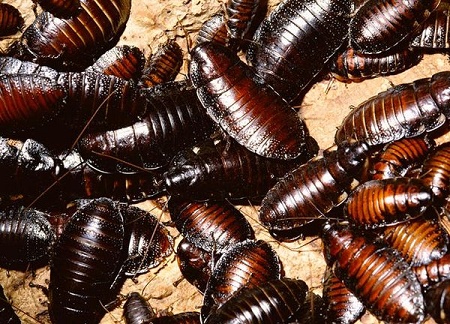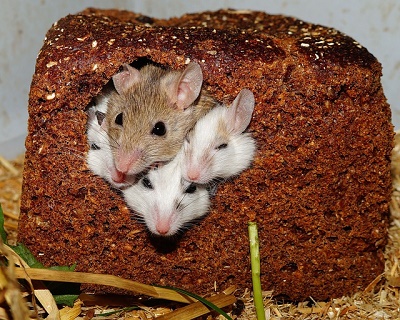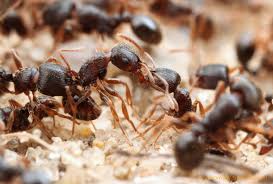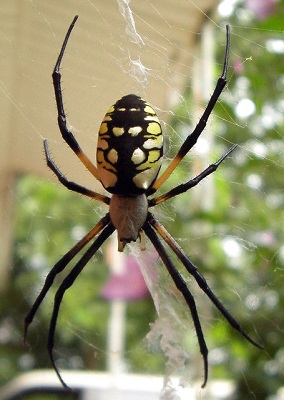Happy Father’s Day from Homestead Pest Management!

Homestead Pest Management for Your West TN Pest Control Solutions

When you call Homestead Pest Management we listen to your problem and prescribe a treatment that will fit your individual needs after a thorough property inspection. We suggest the most beneficial service for your needs without overcharging for additional services you don’t need, because we feel that you should only pay for what is necessary to properly protect your property and not what makes us the most money.
With Homestead Pest Control, you have multiple options for Pest Control including:
- One-Time Service Visits
- Monthly Service Visits
- Bi-Monthly Service Visits
- Quarterly Service Visits
- Inside Only Treatments
- Outside Only Treatments
- And MORE!
At Homestead Pest Management, we live with our families in West Tennessee and understand that times are hard for everyone. For that reason, we do not hold our fellow residents to a binding contract. If you need to cancel at any time, you can, and we will still be here for you when conditions improve.
Homestead Pest Management can take care of all your pest control needs whether it be roaches, ants, termites, mosquitoes, spiders or anything else that’s bugging you. Contact us today to schedule a complete individualized assessment of your home and property.
Summer Temps can make Mice Seek Shelter

West TN just gets hotter and hotter as Summer deepens, and mice, like all living things, start looking for shelter from the sun’s damaging rays when the temperatures begin to soar. Homes, sheds, out buildings, warehouses, etc., are often where these furry little rodents run.
If you have seen tracks, gnawing marks, or droppings, these indicate areas where mice are or have recently been active. Their nests, made from fine shredded paper or other stringy materials, are often found in dark, dry, sheltered locations. Though mice usually stay out of sight during daylight hours, if there are many, they may be seen before dark. They have a distinctive, musty smell that is evident in their nests or in large groups. They are gray or brown rodents with relatively large ears and small eyes. An adult weighs about 0.5 ounces and is about 5.5-7.5 inches long, including the 3-4 inch tail.
House mice are considered one of the most destructive pests in the United States. They can survive in very small areas with limited food and barely any shelter under a variety of conditions in and around homes and farms. House mice eat and/or destroy food meant for pets and humans. They contaminate food-prep areas with their feces and urine, which can contain salmonella and lead to food poisoning. Their constant gnawing causes damage to structures and property. If you suspect you have a mouse problem, let Homestead Pest Management come into your home or other structure and do a thorough assessment to determine the best course of action.
House mice will eat many kinds of food but usually feed on cereal grains and corn. They eat often, nibbling bits of food here and there. They have keen senses and are excellent climbers. Mice can run up any rough vertical surface by clinging with their toenails and toes. They can fit through a crack small enough that only a pencil will fit into! They are also very prolific – in a single year (the average life span of a house mouse), a female may have 5-10 litters of usually 5-7 young each litter. That’s a bunch of mice!
Homestead Pest Managment is your best stop in West TN for the extermination and prevention of a house mice infestation as well as all other types of pest control. We pride ourselves on our accurate, thorough assessments of your home and property, and are known for our personalized ongoing pest-control plans. Contact us today and let us help you rid yourself of any pest problem that you may have.
Pesky Summertime Pests can be Especially Problematic for Pets

Summer is almost here, and with it comes fun in the sun, camping and hiking, and trips to the lakeside. But along with this season of fun and relaxation comes the usual summertime pests. According to a recent article on PetMD.com, “fleas, ticks, and mosquitoes are all visual reminders of the itchy woes we and our pets have to deal with, but there are also the unseen pests. Waterborne parasites and bacterial infections, to mention just two, are also typical summertime plagues.
While we don’t want to get your head spinning from worrying too much about all the things there are to worry about, we do want you to know what you and your pets are up against, and what you might be able to do to mitigate any ill effects. As G.I Joe would say: “Knowing is half the battle.”
Fleas
These pests are nearly impossible to avoid for an entire season. Even with shampoos, collars, powders and sprays, your pet may still end up with fleas. The flea life cycle includes the adult flea, eggs, larvae and pupa. The adult fleas are responsible for the biting that leads to itching, but cannot survive long if they are not on the pet, and once they lay their eggs they fall off the pet. Fleas also lay their eggs in shady areas outside and around the house. Most owners first notice frequent and severe itching and scratching, hair loss, and scabs on their pet. Many times the hind end is affected more than the front of the body or the head. Other side effects include anemia, tapeworm infection (a parasite which finds an intermediate host in the flea), pruritis (intense itching with inflamed skin), and hypersensitivity. There is also plague, and in cats, Rickettsia felis, and Bartonella henselae. The best way to check for fleas is with a flea comb. Frequent bathing and combing are essential components of any flea treatment program. To learn more about some of the natural methods for controllling fleas, see our article here.
Ticks
A lovely day out in the woods, communing with nature, breathing fresh air. These are the joys of summer. Unfortunately, ticks like these spots, too, and they don’t mind hanging around to wait for warm blooded travelers like you and your pet to hitch a ride on. Ticks have a hard-backed shield that can be felt as small bumps during regular petting. They are also easily visible when the fur is parted. Side effects include blood loss anemia, hypersensitivity, pruritis, and damage to the lymphatic, immune, and nervous systems. Some of the more serious diseases that ticks can transmit are the Rocky Mountain spotted fever, Lyme disease, ehrlichiosis, and babesiosis. If you will be spending time in grassy or wooded areas with your pet, be sure to do a tick inspection daily so that the tick can be removed before damage can be done. If you don’t know how to remove a tick the proper way, make sure to become familiar with the proper technique before doing it. You don’t want to end up with a worse situation because of improper removal. There are a few natural methods for avoiding ticks.
Mosquitoes
Even your indoor pets are at risk for some of the miseries brought on by mosquitoes, since mosquitoes can still get inside on occasion and can bite through screens on windows, where cats tend to rest. Of course, mosquitoes cause itchy bumps, and that is painful enough, but there are also some serious and life-threatening diseases to be aware of. Heartworm, a roundworm that can infect both cats and dogs, is a silent killer that can be easily treated if caught in time. Two mosquito-borne diseases that affect both humans and domestic animals are the Saint Louis Encephalitis (SLE), which attacks the brain, and the West Nile Virus (WNV).”
At Homestead Pest Management, we do battle against all the pests that plague both people and pets. We offer the latest in mosquito control in addition to other services that protect your home, property, and business from fleas, ticks, rodents, termites, etc. Contact us today for a personalized assessment and protection plan.
Ants Getting on Your Last Nerve? Let Homestead Help!

Ants are among the most common and prevalent household pests. Not limited to houses and gardens, ants also invade any place that provides them with food and water. While they do have a few beneficial contributions to our ecosystem, they conversely nurture insects such as aphids, soft scales, whiteflies, and mealybugs, increasing the damage from these pests to both outdoor and sometimes indoor plants. Our goal at Homestead Pest Management (HPM)is to help you eliminate these pesky little bugs and keep them from returning to ruin more than just a picnic.
Texas A&M University’s Agri-Life Extension office’s pamphlet on “Managing Household Ant Pests” says:
“To manage an ant infestation in the home, you must first identify the species. The next step is to learn about the biology of that species and determining where the colony might be nesting.” Our professionals at HPM will come out and do an assessment of the property that needs treating, and decide exactly what type pf problem you have before discussing possible plans of attack.
Don’t put up with the ANT-ics of these tiny pests – let the HPM team take care of all your pest-control needs. Contact us today to begin your customized plan of care for your home, yard, business, or other property.
Happy Mother’s Day from Homestead Pest Management!

Ticks are a Concerning West TN Pest This Spring
According to Jerry Genosie of Natural Unseen Hazards:
“Ticks are raising new concerns in Tennessee as new types and infections emerge. Tick-related illnesses have more than doubled in Tennessee since 2005. There were almost 400 cases last year, most of them Rocky Mountain spotted fever. There have been six deaths from Rocky Mountain fever in the state since 2001. Certain species of ticks that were uncommon in the state are being found in new areas. Ticks that were previously rare in Tennessee, such as Gulf Coast and deer ticks, have now been found to be much more widespread, possibly because of climate change. Both are associated with tick-borne infections. “It is a big concern because it can result in a fatality,” Abelardo Moncayo of the Tennessee Department of Health told The Tennessean.
Angela Doss said she lost three months to a tick bite. After camping at Old Hickory Lake, she woke up with a stiff neck and a blinding headache. Her brain was swelling from a bacterial infection from a tick. Doss was hospitalized for six days and saw a neurologist weekly for three months. She missed months of work. “I don’t go camping anymore,” she said with a laugh. “Or if I do, I am adamant about checking (myself) for ticks. Not everybody who gets bit by a tick gets ill. I was just the one who got it.”
Graham Hickling, a University of Tennessee research professor who is studying Lyme disease and other tick illnesses, said some tick-borne illnesses, if untreated, “could go very bad, very fast.” Nationally, Lyme disease gets the most attention. It has been concentrated in the Northeast, where deer ticks, also called black-legged ticks, transmit it. Hickling helps lead a five-state research group on Lyme. His students have found black-legged ticks throughout Tennessee, but in low numbers. And tests have not found the ticks carrying the pathogen that causes Lyme in humans.
Tick-borne issues in the Southeast are other things, he said. “If you are getting infected, the first candidate is the Lone Star tick, which is common and aggressive.” Lone Star ticks have been linked to ehrlichiosis, the illness that felled Doss. They also may carry Rocky Mountain spotted fever, which is being renamed as spotted fever rickettsiosis. Tennessee is among four Southeast states that have accounted for almost half of all nationwide cases of spotted fever since 1995.
In 2009, the state recorded its first case of babesiosis. The patient was a deer hunter, and the state tracked where he had been and found the Babesia parasites in deer ticks there, Moncayo said. Babesia requires different drugs than other tick infections. It can be spread through many types of contact, and there is no screening for donors, Moncayo said. All those factors have prompted the state and the federal Centers for Disease Control and Prevention to begin tracking Babesia cases for the first time this year. People are probably encountering ticks more often as suburban growth pushes into tick habitat, Moncayo said. Ticks typically get active when weather becomes warm in the spring. Infection reports peak in June and July.
Treatment is most successful within five days of symptoms. That’s why anyone who feels ill and has been around ticks needs to go to a physician and start treatment, even before blood tests show an infection. Most people recover fully, but some infections can cause lasting damage. And the longer an infection goes untreated, the more harm can be done. Moncayo said ticks are part of life in Tennessee. “You should still be able to enjoy the outdoors, but be aware they’re out there,” he said. “If you have a tick bite, don’t shrug off symptoms if they develop. But if you get a tick, don’t worry if you don’t feel sick.”
Homestead Pest Management offers an extensive array of pest control services, each individualized to your specific needs based on an initial on-site assessment of your property and a determination of the precise pest problem(s) you have. We then suggest the most beneficial service for your needs without overcharging for additional services you don’t need, because we feel that you should only pay for what is necessary to properly protect your property and not what makes us the most money. Ticks, spiders, ants, termites, fleas, rodents, bedbugs: are any of these pesky critters bothering you? How about mosquitoes? As part of our other services, Homestead Pest Management offers the latest in Mosquito Control! We have several services and packages to accommodate everyone’s budget. We can also install the MistAway System and service your system all summer long.
We have service plans for every schedule and budget, and best of all, we do not hold you to a binding contract – you can terminate services anytime with no hassle whatsoever.
At Homestead Pest Management we understand that proper protection from pests can be costly and for that reason we regularly provide coupons to help our customers get the treatment they need to care for their property, and our refer-a-friend program earns discounts for you as well for every qualified referral. Control the pests on your West TN property before they start controlling you! Contact us at Homestead Pest Management today to find out more!
Spring Gardeners – be on Guard!

According to Organic Gardening online (www.organicgardening.com), there are 10 pests that gardeners should watch for and prevent in order to have successful gardens:
“Top Ten Garden Insect Pests
The following list of pest descriptions and control measures provides a good starting point for tackling pest control in gardens throughout the United States and Canada. Control solutions are listed in order of environmental friendliness. Botanical sprays, which can have detrimental effects on beneficial insects and other animals, should be used only as a last resort.
1. Aphids (many species).
Tiny, pear-shaped; long antennae; two tubes projecting rearward from abdomen.
Host/Range: Most fruits and vegetables, flowers, ornamentals, shade trees. Found throughout North America.
Damage: Aphids suck plant sap, causing foliage to distort and leaves to drop; honeydew excreted on leaves supports sooty mold growth; feeding spreads viral diseases.
Control: Wash plants with strong spray of water; encourage native predators and parasites such as aphid midges, lacewings, and lady beetles; when feasible, cover plants with floating row cover; apply hot-pepper or garlic repellent sprays; for severe problems, apply horticultural oil, insecticidal soap, or neem.
2. Cabbage maggot (Delia radicum)
Adults: 1⁄4-inch gray flies. Larvae: white, tapering maggots.
Host/Range: Cabbage-family crops. Found throughout North America.
Damage: Maggots tunnel in roots, killing plants directly or by creating entryways for disease organisms.
Control: Apply floating row covers; set out transplants through slits in tar-paper squares; avoid first generation by delaying planting; apply parasitic nematodes around roots; burn roots from harvested plants; mound wood ashes or red pepper dust around stems.
3. Caterpillars (many species)
Soft, segmented larvae with distinct, harder head capsule; six legs in front, fleshy false legs on rear segments.
Host/Range: Many fruits and vegetables, ornamentals, shade trees. Range varies with species.
Damage: Caterpillars chew on leaves or along margins; droppings soil the produce; some tunnel into fruits.
Control: Encourage native predators, parasites; hand pick; apply floating row covers; spray with Bt (Bacillus thuringiensis) or spinosad.
4. Cutworms (several species)
Fat, 1-inch-long, gray or black segmented larvae; active at night.
Host/Range: Most early vegetable and flower seedlings, transplants. Found throughout North America.
Damage: Cutworms chew through stems at ground level; they may completely devour small plants; most damaging in May and June.
Control: Use cutworm collars on transplants; delay planting; hand pick cutworms curled below soil surface; scatter bran baits mixed with Btk (B.t. var. kurstaki) and molasses before planting.
5. Colorado potato beetle (Leptinotarsa decemlineata)
Adults: yellow-orange beetles with 10 black stripes on wing covers. Larvae: orange, hump-backed grubs with black spots along sides. Eggs: yellow ovals, laid in upright clusters.
Host/Range: Potatoes, tomatoes, eggplant, petunias. Found throughout North America.
Damage: Beetles defoliate plants, reducing yields or killing young plants.
Control: Apply floating row covers; use deep straw mulches; hand pick; attract native parasites and predators; spray with Beauveria bassiana or spinosad; spray with neem.
6. Mexican bean beetle (Epilachna varivestris)
Adults: oval, yellow-brown, 1⁄4-inch beetles with 16 black spots on wing covers. Larvae: fat, dark yellow grubs with long, branched spines.
Host/Range: Cowpeas, lima beans, snap beans, soybeans. Found in most states east of the Mississippi River; also parts of Arizona, Colorado, Nebraska, Texas, Utah.
Damage: Adults and larvae chew on leaves from beneath, leaving characteristic lacy appearance; plants defoliated and killed.
Control: Apply floating row covers; plant bush beans early; hand pick; plant soybean trap crop; put out lures to draw spined soldier bugs (predators) to your yard. Spray Beauveria bassiana, insecticidal soap, or neem.
7. Flea beetles (several species)
Small, dark beetles that jump like fleas when disturbed.
Host/Range: Most vegetable crops. Found throughout North America.
Damage: Adults chew numerous small, round holes in leaves; most damaging to young plants; larvae feed on plant roots.
Control: Apply floating row covers; repel the pests by spraying plants with garlic spray or kaolin clay; for a serious infestation, try repeated sprays of Beauveria bassiana or spinosad.
8. Tarnished plant bug (Lygus lineolaris)
Fast-moving, mottled, green or brown bugs, forewings with black-tipped yellow triangles. Nymphs: similar to adults, but wingless.
Host/Range: Many flowers, fruits, vegetables. Found throughout North America.
Control: Adults and nymphs suck plant juices, causing leaf and fruit distortion, wilting, stunting, and tip dieback.
Damage: Keep garden weed free in spring. Apply floating row covers; encourage native predatory insects; spray young nymphs with Beauveria bassiana or neem.
9. Japanese beetles (Popillia japonica)
Adults: metallic blue-green, 1⁄2-inch beetles with bronze wing covers. Larvae: fat, white grubs with brown heads.
Host/Range: Many vegetables and flowers, small fruit. Found in all states east of the Mississippi River.
Damage: Adults skeletonize leaves, chew flowers, may completely defoliate plants; larvae feed on lawn and garden plant roots.
Control: Shake beetles from plants in early morning; apply floating row covers; set out baited traps upwind of your garden on two sides and at least 30 feet away; apply milky disease spores or Herterorhabditis nematodes to soil; spray beetles with insecticidal soap.
10. Scales (more than 200 species)
Adults: females look like hard or soft bumps on stems, leaves, fruit; males are minute flying insects. Larvae: tiny, soft, crawling larvae with threadlike mouthparts.
Host/Range: Many fruits, indoor plants, ornamental shrubs, and trees. Found throughout North America.
Damage: All stages suck plant sap, weakening plants. Plants become yellow, drop leaves, and may die. Honeydew is excreted onto foliage and fruit.
Control: Prune out infested plant parts; encourage native predators; scrub scales gently from twigs with soft brush and soapy water, rinse well; apply dormant or summer oil sprays; spray with neem oil.”
Homestead Pest Management can help you with all your pest prevention and control needs, so contact us today to hear about all our services and to schedule a personalized pest assessment for your home or business.
Springtime is for Spiders!

Spring time is when all creepy crawlies start getting out and about again, and especially spiders. Most of us have a healthy fear and dislike of the eight-legged freaky little pests. While, admittedly, many species of spiders are helpful in that they help control insect populations, there are also those that are harmful to people and pets. Take the brown recluse spider, for example: this spider lives in dark corners and places inside houses, between books on bookshelves, under furniture, and in boxes or bags that are in dark, dry places. Though not usually overly aggressive, humans do get bit fairly frequently by brown recluses because they share the same habitat, and the arachnid is often not easily seen.
In the spring, there is also an increase in the number of garden spiders out and about, and as you go about planning and planting your garden, you are likely to run into a few of the little beasties.
If you have seen spiders in your home or on you property, and you’d like to not just get rid of those that are there, but to also take preventative action, let our Homestead Pest Management team come to your West TN home or property, assess the level of the problem you have, and prescribe a course of action that best meets your needs. No contract required! Contact us today!
Happy St. Paddy’s Day from HPM!

